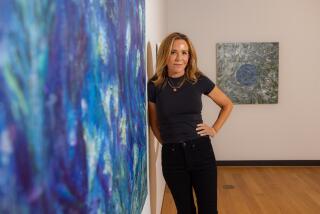ART REVIEW : BRODIE GOES TO BLACK IN NEW WORKS
- Share via
EL CAJON — San Diegans now have a rare opportunity to see the works of John Brodie in some depth at the Grossmont College Art Gallery. It is fully three years since his works were last seen in a solo exhibition at Pawn Shop 2 (which has subsequently become the Patty Aande Gallery). It is astonishing that an artist of Brodie’s quality survives in an environment where, frankly, he is not appreciated.
One of the strongest artists residing in this city, Brodie has slowly but consistently developed a distinctive vision. He is no stranger to “the dark nights of the soul,” but through his art he has mitigated whatever menace there is and revealed the wild spirits of those “dark nights” to be instructive companions rather than destructive enemies.
In addition, he has worked inventively with unusual materials, including Tyvek, an industrial product, and common staples. Typically, he makes his compositions by stapling together pieces of Tyvek painted with acrylics, then attaches them to the wall with push-pins. His works are, then, free-form paintings that relate to walls as fields--that is, as figures on the walls instead of on canvas. Unlike most paintings in frames, they authoritatively command space; their installation is crucial to their appreciation.
The works in the earlier Pawn Shop 2 exhibition and at the Jewish Community Center in 1981 were brightly colored and festive. In making his “Vestments” series, for example, Brodie had been strongly influenced by a journey through Italy and especially by the precious and sacred objects in the Treasury of San Marco in Venice. That some viewers identified them as kachinas, or Pueblo folklore objects, however, is a measure of their evocativeness.
Partly in reaction against the brightness and seductiveness of these earlier works, Brodie has created a series of what he calls his “Black Paintings,” which visitors will see at Grossmont College. Most of them are also made of Tyvek and staples, but they are generally somber psychologically as well as physically. They are powerful images combining primitive visceral energy with sophisticated, contemporary high culture. Not all of them are successful, but there is nothing trivial, nothing effete, about them. They are serious, but some are also playful.
Three drawings in acrylic on paper as a series entitled “Twisted Man” are variations on one theme. The common image is a festishistic, large-headed, squat figure, aggressively erotic but also comical, whose prominent eyes stare out of a big, dumb face. The three images differ from one another, however, in limited palettes but varied gestures.
The theme appears as well in three other figures in Tyvek--”Dwarf,” “Hanging Man” and another “Twisted Man.”
“Magus,” with a pointed head, masklike face and long arms with prominent, mittlike hands, conveys a very strong sense of supernatural power. “Cat” is a beast “red of tooth and claw” rather than a nice kitty. “Icon” is a grotesque borrowing of a traditional form but reverently strong.
Of special interest is a series of large diptychs in which the left-hand elements transform themselves into the right-hand elements. Brodie has referred to these works, entitled “Scenarios,” as “a kind of performance or visual theater.”
“Rune,” a tripartite irregularly shaped work, in its abstractness is much less suggestive than the figurative works and is indicative of a new course that Brodie is pursuing. In the context of this exhibition, however, it seems out of place, as does the small work “Crystal,” which, despite its formal concerns, is unfortunately reminiscent of a patchwork pillow.
The installation of the works is crowded, and it would have been appropriate to have edited the selection and allowed more space for those included.
Nevertheless, there is a great physical, intellectual and spiritual energy in this exhibition, which continues through Dec. 19.
More to Read
The biggest entertainment stories
Get our big stories about Hollywood, film, television, music, arts, culture and more right in your inbox as soon as they publish.
You may occasionally receive promotional content from the Los Angeles Times.










